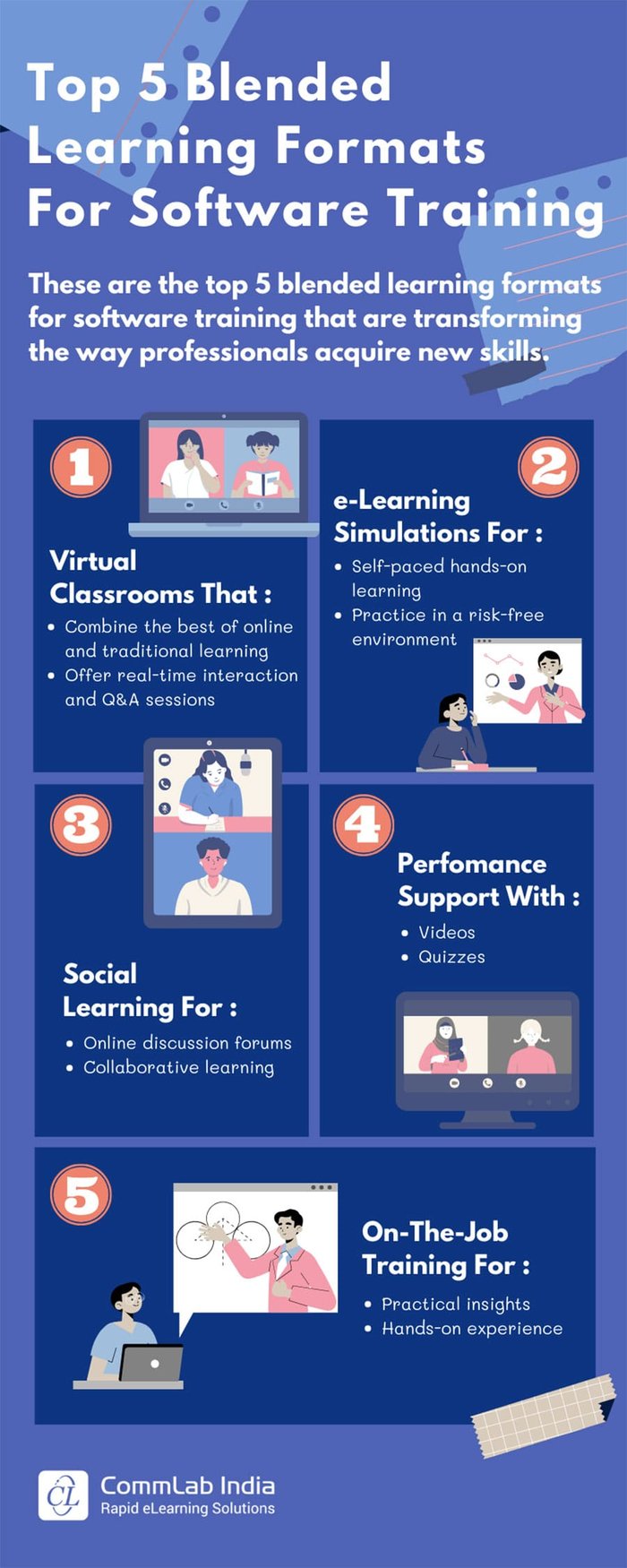Top 5 Blended Learning Formats for Software Training [Infographic]
Blended learning is the need of the modern-day training scenario. Software training is no exception. Read on to know the top 5 blended learning formats for software training.

Are you tasked with providing software training to the modern-day employees? This becomes even more challenging when we know that the IT world is evolving constantly. Its complex pathways require sharp skills and agile adaptation. Therefore, the traditional training methods alone might leave the learners lost in the wilderness. But fear not! Blended learning brings a ray of hope for both trainers and learners. It combines the best traits of online and offline training to ensure high-impact, engaging learning experience.
In this blog, we’ll dive deeper into blended learning method. Firstly, we’ll understand the concept of blended learning, its benefits in corporate training, and finally learn about the top 5 blended learning formats for software training.
Without any further delay, let’s start.
What is Blended Learning?
Blended learning is an training strategy that integrates traditional face-to-face instruction (offline training) with online learning components. It combines the strengths of in-person training, such as real-time interaction and rapport building with the flexibility and accessibility of digital platforms. This hybrid approach allows learners to engage with content through various mediums, such as classroom sessions, virtual classrooms, online modules, and interactive simulations.
→ Download Now: Redefining Generative AI for Dynamic L&D Teams
Benefits of Blended Learning in Corporate Training
Offers Flexibility and Accessibility
Blended learning offers flexibility in terms of when and where employees can access training materials. With a mix of in-person and online components, employees can choose to learn at their own pace and convenience. This flexibility is particularly beneficial for a workforce with diverse schedules and commitments.
Promotes Cost-Efficiency
Blended learning is a cost-effective solution as it reduces various expenses associated with traditional training, such as travel, accommodation, and venue costs for sessions. Furthermore, the ease of reusing and updating online materials reduces the necessity for constant reprints and distribution.
Improves Engagement and Interactivity
Blended learning encourages active participation and engagement. Different types of eLearning interactivities and multimedia elements complement traditional training methods. This helps in keeping employees motivated and interested. You can leverage interactivities like click-throughs, drag-and-drop, fill in the blanks, etc. For multimedia elements, you can use animations, GIFs, audio clips, videos, and more. Such diverse range of options caters to different learning preferences and ensures a more engaged and participative workforce.
Top 5 Blended Learning Formats for Software Training
Wrapping It Up!
Blended learning enriches the corporate training experience by combining the strengths of traditional and digital methods. Various benefits discussed in this blog make it an ideal approach for organizations that wish to optimize their training programs. It helps foster a skilled and adaptable workforce and ensures that the learners are ready for the challenges of the modern business world. If you want to take a step further in improving your training programs, missing out on leveraging artificial intelligence (AI) can be a big blow. So here’s a free eBook to walk you through the AI revolution and help you make the most of it. Check it out right away!







